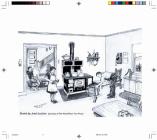2
The fire in the stove had to be started as soon as one got up in preparation for daily cooking and for heat in the winter. To make the fire or refuel it one had to lift the cover of the openings for the additional wood/coal. The fire box was filled with wood, kindling and some piece of newspaper to which a lit match began a good fire before coal was added to have sustaining heat.4
All activities that took place in the home centered around the stove. The lady of the house had to be an engineer of her cook stove.Q: What did great- grandma have to do in order to get the stove running?
A: There were two dampers on the front of the stove and one on the left- hand side. These were used to make a draft to get the fire going. They were slid back and forth to determine the size of the opening. To start the fire, paper was used, then kindling, which are small pieces of wood. When that got going good, the larger pieces of wood, soft or hard coal were used.
Q:How did she know how hot the oven was?
A:There was a temperature gauge on the oven door. If the gauge did not work - she used her hand and guessed.
Q: How often did the ashes need to be cleaned out of the stove?
A: Ashes had to be shaken out into a tray underneath the firebox, which was then removed and dumped on the ash pile at least once a day. This was usually the boys' chore. The chickens used this pile of ashes to dust themselves to keep themselves clean.
Q: How did they get hot water?
A: There was always a reservoir on the right side of the stove. This held extra water and was always warm. On wash days or bath days a double boiler was put on the fron of the stove for hot water. You bathed in front of the oven door, youngest to oldest.
Q: What was used to keep the food warm?
A: A warming oven across the top of the stove was used for keeping food warm after being cooked. Others used it for storing pots and pans or sad irons.
Q:Did she have to do anything special to the stove when baking things like bread?
A:To bake bread you had to know just how much feul to put into cook a batch of bread.
Q: How was the stove able to run all night long during the winter?
A: The fathers would stay up all night to stoke the fire so that the house would stay warm.
Q: Was the stove used for anything else?
A: On cold days or nights chicks and newborn calves would be brought in and put by the stove.






